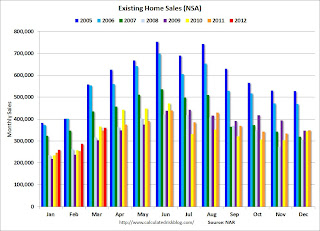by Calculated Risk on 4/19/2012 11:52:00 AM
Thursday, April 19, 2012
Existing Home Sales: Inventory and NSA Sales Graph
The NAR reported inventory decreased to 2.37 million in March, down from 2.40 million in February. This is down 21.8% from March 2011, and up 3% from the inventory level in March 2005 (mid-2005 was when inventory started increasing sharply). Inventory was down slightly from March 2004. This decline in inventory has been a significant story over the last year.
Here are some of the reasons for the decline in inventory (mostly a repeat from a post last month):
• The NAR reports active listings, and although there is some variability across the country in what is considered active, most "contingent short sales" are not included. "Contingent short sales" are strange listings since the listings were frequently NEVER on the market (they were listed as contingent), and they hang around for a long time - they are probably more closely related to shadow inventory than active inventory. However when we comparing inventory to 2005, we need to remember there were no "short sale contingent" listings in 2005. However, in the areas I track, the number of "short sale contingent" listings is also down sharply year-over-year.
• There are probably a large number of sellers "waiting for a better market", and we could call this pent-up supply. When the market eventually improves, this pent-up supply will come on the market and probably keep prices from rising - but having less listed inventory now means less downward pressure on prices now.
• There is a seasonal pattern for inventory, and usually December and January have the lowest inventory levels for the year. Although there is some variability, usually inventory increases about 10% to 15% from January to mid-summer. That would put inventory at around 2.55 to 2.7 million by July (up from 2.33 million in January). At the current sales rate, this would push the months-of-supply measure up to 6.8 to 7.2 months from the current 6.3 months. The 1.7% inventory increase from January to March was below the normal seasonal increase of around 8%.
• The number of completed foreclosures declined in 2011 and are expected to increase in 2012. This will probably lead to more REO (lender Real Estate Owned) listed for sale and some increase in the level of inventory.
I don't think this increase will be huge. My guess is that at most this will add 200 thousand listed REOs to the expected seasonal increase that would put listed inventory at 2.75 to 2.9 million in mid-summer - or about 7.4 to 7.8 months-of-supply at the current sales rate. That is higher than normal, but inventory would still be down 10% or more from 2011.
• Tom Lawler has pointed out that there has been a substantial increase in the number of SF homes purchased by investors with the explicit intention to rent the homes out for several years and this is probably another reason for the decline in inventory.
The bottom line is the decline in listed inventory is a big deal, and will take the downward pressure off of house prices. Just like last year, inventory will be something to watch closely all year.
The following graph shows inventory by month since 2004. In 2005 (dark blue columns), inventory kept rising all year - and that was a clear sign that the housing bubble was ending.
 Click on graph for larger image.
Click on graph for larger image.
This year (dark red for 2012) inventory is at the lowest level for a March since 2005, and actually slightly below the level in 2004 (not counting contingent sales). Inventory is still elevated - especially with the much lower sales rate.
The following graph shows existing home sales Not Seasonally Adjusted (NSA).
 Sales NSA (red column) are above the sales for the 2008, 2009 and 2011 (2010 was higher because of the tax credit). Sales are well below the bubble years of 2005 and 2006.
Sales NSA (red column) are above the sales for the 2008, 2009 and 2011 (2010 was higher because of the tax credit). Sales are well below the bubble years of 2005 and 2006.
It is also important to note that distressed sales were down in March. From the NAR:
Distressed homes – foreclosures and short sales .. – accounted for 29 percent of March sales (18 percent were foreclosures and 11 percent were short sales), compared with 34 percent in February and 40 percent in March 2011.A decline in existing home sales due to fewer distressed sales is a positive for the housing market. Of course distressed sales will probably increase again following the mortgage servicer settlement.
Earlier:
• Existing Home Sales in March: 4.48 million SAAR, 6.3 months of supply
• Existing Home Sales graphs


